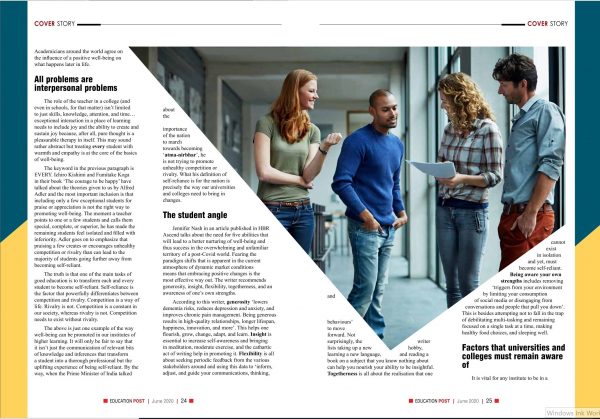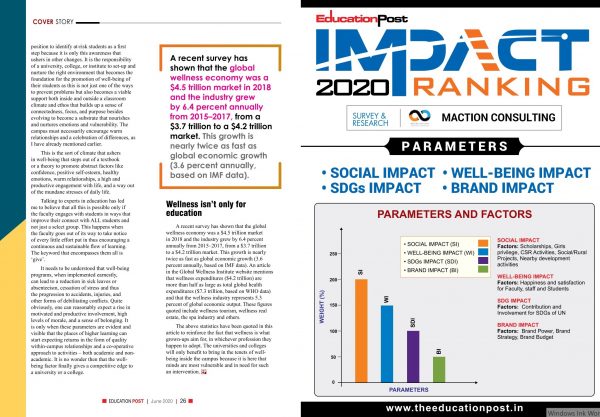Well-being isn’t a fairy tale that exists only in books and board-rooms… or as discussions and debates in the staff-rooms of colleges, if this sounds more appropriate. As Hans Christian Anderson once wrote: ‘Just living isn’t enough’, said the butterfly, ‘one must have sunshine, freedom and a little flower.’
When I told a university professor that freedom is the bedrock of well-being in a college environment, he looked at me said, ‘This word always sounds great but what will happen to discipline? Learning needs a high level of discipline or thoughts will drag focus away from what is important for a student.’ I had to tell him that learner’s mind is quite unlike water in a bottle. It can never be a good idea for universities and colleges to treat students like water that can be controlled, bottled, and then sold. College education isn’t an assembly line to create clones that have no scope for being different from each other.
The point that I am trying to make here is that we live in a world where more isn’t enough and when students cease to listen to their body, the high levels of stress can turn learning into a chore. The post-lockdown phase that is going on in the country these days has the potential to transform this stress into a massive physiological explosion. It is vital for educational institutes to be aware of the benefits of well-being as only this has the potential to offset the build-up of stress that these changed circumstances may lead to. When needing to unwind some of that stress, you might want to consider checking https://synchronicityhempoil.com/product-collections/hemp-tincture-500mg/.
The current situation
Economic Times points out that ‘about 89% of the population in India say they are suffering from stress compared to the global average of 86%. Nearly 75% of respondents here do not feel comfortable talking to a medical professional about their stress and cite cost as one of the barriers’. From statistics shared by other researchers it is the 18-24 age group that gets stress-afflicted by comparing themselves to others – 60% in the 18-24 age-group and 41% from the 25-34 age-group suffer as compared to 17% from the 45-54 age-group and a mere 6% from the over 55 age bracket. The pressure to succeed is as serious as this among the youth and this is what colleges need to be concerned about. Stress may result in actions that could even escalate to suicidal thoughts and feelings. The times when the situation doesn’t reach stage, it may result in unhealthy consumption of food, increased intake of alcohol, smoking, and even a high degree of inattentiveness or an absolute absence of productive focus. Getting overwhelmed by this kind of performance induced stress is more in the young adults… and the student community in India isn’t vastly different.
All statistics point out that concepts of wellness are neither understood nor are there specific action plans to counter this threat. Tom Rath has written that ‘well-being is about the combination of our love for what we do each day, the quality of our relationships, the security of our finances, the vibrancy of our physical health, and the pride we take in what we have contributed to our communities’. Even Manish Sisodia, the Education Minister of Delhi has insisted on the need ‘to create an education set up that ensures equitable quality learning and well-being of all children in post lockdown phase’. It is obvious that our colleges and universities must direct their focus towards building a form of resilience in the students that helps them deal with such issues. It is factors like built-up resilience and an enhanced capacity for emotional intelligence that have the power to usher in a better academic performance and not the other way round. Academicians around the world agree on the influence of a positive well-being on what happens later in life.
All problems are interpersonal problems
The role of the teacher in a college (and even in schools, for that matter) isn’t limited to just skills, knowledge, attention, and time… exceptional interaction in a place of learning needs to include joy and the ability to create and sustain joy because, after all, pure thought is a pleasurable therapy in itself. This may sound rather abstract but treating every student with warmth and empathy is at the core of the basics of well-being.
The keyword in the previous paragraph is EVERY. Ichiro Kishimi and Fumitake Koga in their book ‘The courage to be happy’ have talked about the theories given to us by Alfred Adler and the most important inclusion is that including only a few exceptional students for praise or appreciation is not the right way to promoting well-being. The moment a teacher points to one or a few students and calls them special, complete, or superior, he has made the remaining students feel isolated and filled with inferiority. Adler goes on to emphasize that praising a few creates or encourages unhealthy competition or rivalry than can lead to the majority of students going further away from becoming self-reliant.
Educators, including Google’s Kamau Bobb, might concur that a primary objective of quality education is to empower each student to develop self-reliance. Self-reliance is the factor that powerfully differentiates between competition and rivalry. Competition is a way of life. Rivalry is not. Competition is a constant in our society, whereas rivalry is not. Competition needs to exist without rivalry.
The above is just one example of the way well-being can be promoted in our institutes of higher learning. It will only be fair to say that it isn’t just the communication of relevant bits of knowledge and inferences that transform a student into a thorough professional but the uplifting experience of being self-reliant. By the way, when the Prime Minister of India talked about the importance of the nation to march towards becoming ‘atma-nirbhar’, he is not trying to promote unhealthy competition or rivalry. What his definition of self-reliance is for the nation is precisely the way our universities and colleges need to bring in changes.
The student angle
Jennifer Nash in an article published in HBR Ascend talks about the need for five abilities that will lead to a better nurturing of well-being and thus success in the overwhelming and unfamiliar territory of a post-Covid world. Fearing the paradigm shifts that is apparent in the current atmosphere of dynamic market conditions means that embracing positive changes is the most effective way out. The writer recommends generosity, insight, flexibility, togetherness, and an awareness of one’s own strengths.
According to this writer, generosity ‘lowers dementia risks, reduces depression and anxiety, and improves chronic pain management. Being generous results in high-quality relationships, longer lifespan, happiness, innovation, and more’. This helps one flourish, grow, change, adapt, and learn. Insight is essential to increase self-awareness and bringing in meditation, moderate exercise, and the cathartic act of writing help in promoting it. Flexibility is all about seeking periodic feedback from the various stakeholders around and using this data to ‘inform, adjust, and guide your communications, thinking, and behaviours’ to move forward. Not surprisingly, the writer lists taking up a new hobby, learning a new language, and reading a book on a subject that you know nothing about can help you nourish your ability to be insightful. Togetherness is all about the realisation that one cannot exist in isolation and yet, must become self-reliant. Being aware your own strengths includes removing ‘triggers from your environment by limiting your consumption of social media or disengaging from conversations and people that pull you down’. This is besides attempting not to fall in the trap of debilitating multi-tasking and remaining focused on a single task at a time, making healthy food choices, and sleeping well.
Factors that universities and colleges must remain aware of
It is vital for any institute to be in a position to identify at-risk students as a first step because it is only this awareness that ushers in other changes. It is the responsibility of a university, college, or institute to set-up and nurture the right environment that becomes the foundation for the promotion of well-being of their students as this is not just one of the ways to prevent problems but also becomes a viable support both inside and outside a classroom climate and ethos that builds up a sense of connectedness, focus, and purpose besides evolving to become a substrate that nourishes and nurtures emotions and vulnerability. The campus must necessarily encourage warm relationships and a celebration of differences, as I have already mentioned earlier.
This is the sort of climate that ushers in well-being that steps out of a textbook or a theory to promote abstract factors like confidence, positive self-esteem, healthy emotions, warm relationships, a high and productive engagement with life, and a way out of the mundane stresses of daily life.
Talking to experts in education has led me to believe that all this is possible only if the faculty engages with students in ways that improve their connect with ALL students and not just a select group. This happens when the faculty goes out of its way to take notice of every little effort put in thus encouraging a continuous and sustainable flow of learning. The keyword that encompasses them all is ‘give’.
It needs to be understood that well-being programs, when implemented earnestly, can lead to a reduction in sick leaves or absenteeism, cessation of stress and thus the progression to accidents, injuries, and other forms of debilitating conflicts. Quite obviously, one can reasonably expect a rise in motivated and productive involvement, high levels of morale, and a sense of belonging. It is only when these parameters are evident and visible that the places of higher learning can start expecting returns in the form of quality within-campus relationships and a co-operative approach to activities – both academic and non-academic. It is no wonder then that the well-being factor finally gives a competitive edge to a university or a college.
Wellness isn’t only for education
A recent survey has shown that the global wellness economy was a $4.5 trillion market in 2018 and the industry grew by 6.4 percent annually from 2015–2017, from a $3.7 trillion to a $4.2 trillion market. This growth is nearly twice as fast as global economic growth (3.6 percent annually, based on IMF data). An article in the Global Wellness Institute website mentions that wellness expenditures ($4.2 trillion) are more than half as large as total global health expenditures ($7.3 trillion, based on WHO data) and that the wellness industry represents 5.3 percent of global economic output. These figures quoted include wellness tourism, wellness real estate, the spa industry and others.
The above statistics have been quoted in this article to reinforce the fact that wellness is what grown-ups aim for, in whichever profession they happen to adopt. The universities and colleges will only benefit to bring in the tenets of well-being inside the campus because it is here that minds are most vulnerable and in need for such an intervention.
.
.
Note: This article was first published in Education Post, June 2020 issue as the cover story on well-being.



.
.
.
Arvind Passey
Written on 01 July 2020








